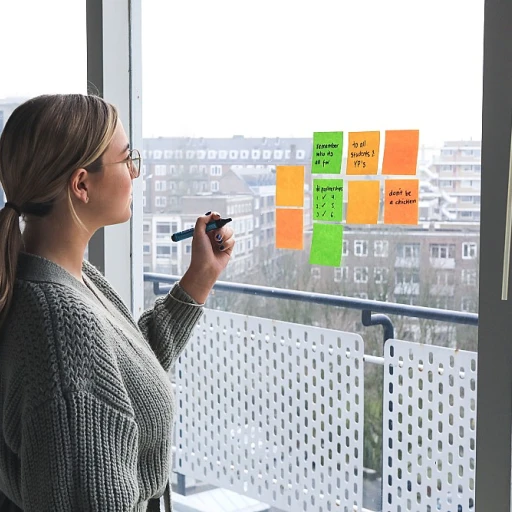
Understanding the Role of Team Building in Work-Life Balance
The Importance of Team Dynamics in Balance
Finding the right balance between work and life is essential for maintaining a healthy and productive workforce. Team building plays a critical role in fostering this balance, as it lays the foundation for strong team dynamics. When done correctly, team building can create an environment where employees feel valued and supported, both in their personal lives and professional roles. This context influences overall employee satisfaction and retention rates, helping companies thrive.
In today's fast-paced work environment, including virtual team settings, it is important to prioritize activities that engage all team members. Team building activities should be designed to encourage communication, collaboration, and, of course, a bit of fun. These activities not only enhance interpersonal connections but also reinforce a positive company culture.
Incorporating tools like Adobe Express into team-building activities can infuse creativity into the process. Whether you're planning a team-building event or a virtual team connection session, using such platforms allows employees to participate actively, regardless of technical requirements or physical location. By utilizing engaging designs and structures, teambuilders can craft experiences that are both memorable and effective in achieving work-life balance goals.
Identifying When Team Building is Effective
Recognizing the Indicators of Effective Team Building
Creating a thriving workplace atmosphere through team building activities is not a one-size-fits-all approach. Knowing when team building is effective involves understanding various signals that can indicate its success. These indicators are beneficial for gauging the impact on both the individual employees and the organization as a whole.
- Increased Employee Engagement: After a successful team building event, you'll usually notice a boost in employee engagement levels. If team members show more enthusiasm in their work and participate more actively in discussions, it's a good sign that the activities hit the mark.
- Improved Communication: Effective team building fosters better communication channels among team members. Teams that previously struggled to communicate may start interacting more openly, which leads to enhanced collaboration on projects.
- Enhanced Problem-Solving Skills: When teams engage in problem-solving activities like virtual escape rooms or design challenges using tools like Adobe Express, their ability to tackle work-related challenges can improve appreciably. Problem-solving as a team strengthens the bond among employees and encourages resourcefulness.
- Strengthened Company Culture: Team building can help solidify the company culture by aligning the goals and values of the organization with those of the employees. This cultural alignment is often reflected in a more cohesive and motivated team.
- Reduced Workplace Stress: Activities that incorporate fun elements such as sports or game-based challenges can lead to stress reduction. Employees return to their work with a refreshed mindset, ready to tackle their tasks more efficiently.
When these positive outcomes are visible, it reinforces the value of investing time and resources into team building initiatives. Being proactive in recognizing and understanding these indicators not only enriches the current work environment but also lays a strong foundation for future team successes. For inspirational ideas on boosting team engagement, check out some inspiring quotes that could serve as motivation for the next team building activity.
Common Challenges in Implementing Team Building
Addressing the Challenges in Team Building Activities
Implementing effective team building activities can help employees in enhancing their work-life balance, yet it does come with its share of challenges. Recognizing and addressing these obstacles is crucial for any organization hoping to foster a positive company culture through team building events. One of the primary issues is the disparity between in-person team building and virtual team building activities. While virtual events provide an opportunity to include remote workers and create flexibility, they often lack the personal connection that is more naturally established in face-to-face interactions. Ensuring inclusivity and engagement in virtual environments requires creative solutions and robust technology. Technical requirements are another critical challenge. Virtual team building activities often rely on tools and platforms such as Adobe Express to facilitate seamless interactions. However, if the team members are not adequately equipped or trained to use these tools, the activity’s effectiveness can be compromised. It's essential to ensure that all employees have access to the necessary technology and are comfortable using it. Time constraints also play a significant role in complicating team building activities. Incorporating these activities into the existing work schedules without encroaching on personal time demands careful planning. Utilizing innovative approaches to integrate team building into work hours can make these events more manageable. Furthermore, the design of team building events can sometimes overlook the diverse interests and personalities within a team. Tailoring activities to be inclusive and appealing, such as incorporating elements of fun, competition, or problem solving, can go a long way in ensuring that everyone in the team will benefit. To learn more about innovative employee appreciation techniques that enhance these activities, you might find these insights valuable. Lastly, maintaining continuous employee engagement can be challenging, especially when team building activities are perceived as repetitive or superficial. Rotating themes and approaches, such as sports college games or themed express challenges, could invigorate interest. Regular feedback from team members following an activity will help refine future sessions to meet the evolving interests and needs of the team.Strategies for Successful Team Building
Key Recommendations for Effective Team Building
Effective team building is crucial for fostering a work-life balance that encourages productivity and employee satisfaction. Here are some strategies to ensure successful team building that resonates with all team members, whether part of a person team or a virtual team:- Define Clear Goals and Objectives: Before initiating any team building activity, it’s essential to have a clear understanding of what you aim to achieve. Whether it's enhancing communication skills or boosting problem-solving abilities, knowing your objectives will help in selecting the appropriate activities.
- Tailor Activities to Team Preferences: Not every team will benefit from the same type of activities. It's important to gauge interests and comfort levels. For instance, a sports college-inspired game might engage active teams, while a virtual adobe express design challenge could captivate more creative-minded members.
- Incorporate Fun and Creativity: Injecting fun into team building activities can improve engagement. Utilize teambuilder platforms like Adobe Express to create interactive and enjoyable experiences that will make employees look forward to participating.
- Mix Physical and Virtual Events: In today’s dynamic work environments, blending in-person activities with virtual events can cater to both onsite and remote employees. This approach ensures inclusivity and maximizes participation across diverse teams.
- Foster an Inclusive Company Culture: Encourage activities that build relationships and enhance company culture. Teams should feel comfortable collaborating and expressing ideas, creating an environment where every member is valued.
- Regularly Schedule Activities: Regular team building events help maintain momentum. Whether monthly team building sessions or seasonal fun challenges, consistency keeps the team spirit alive and flourishing.
- Utilize Feedback for Continuous Improvement: After each team building activity, gather feedback from participants to understand what worked and what didn’t. This information will help refine future activities, ensuring they continue to meet the team's needs.
Measuring the Impact of Team Building on Work-Life Balance
Evaluating the Success of Team Building Initiatives
Measuring the impact of team building on work-life balance can be a complex task, but it's essential for understanding its true value. Effective evaluation requires a combination of qualitative and quantitative methods to capture a comprehensive picture of how these activities influence employees' lives.
Key Metrics to Consider
- Employee Engagement: Monitoring changes in employee engagement levels before and after team building activities can provide insights into their effectiveness. Surveys and feedback forms are useful tools for gauging this metric.
- Work-Life Satisfaction: Regular assessments of work-life satisfaction can help determine if team building activities are contributing positively. Consider using anonymous surveys to encourage honest feedback.
- Productivity Levels: Analyzing productivity metrics can reveal whether team building activities have led to improved collaboration and efficiency among team members.
- Attendance and Participation: Tracking attendance and participation rates in team building events can indicate the level of interest and perceived value among employees.
Feedback Mechanisms
Incorporating feedback mechanisms is crucial for refining team building initiatives. Encourage open communication channels where employees can express their thoughts on the activities. This feedback will help in tailoring future events to better meet the needs of the team.
Long-Term Impact Assessment
While immediate feedback is valuable, assessing the long-term impact of team building activities is equally important. Regularly revisiting the outcomes of past events can help identify trends and inform future strategies. Consider conducting follow-up surveys several months after the activities to evaluate their lasting effects on work-life balance.
Utilizing Technology for Measurement
Leveraging technology can streamline the measurement process. Tools like Adobe Express can assist in designing surveys and collecting data efficiently. Additionally, virtual team building activities can be tracked using online platforms, providing real-time data on participation and engagement.
Ultimately, the goal is to create a feedback loop that continuously improves team building efforts, ensuring they remain a valuable component of enhancing work-life balance within the organization.
Case Studies: Successful Team Building Initiatives
Inspirational Accounts of Team Building Success
To illustrate the potential work-life balance improvements offered by effective team building activities, exploring real-world accounts can be highly insightful. Consider a company that embraced virtual team building solutions during a significant transition to remote work. The team aimed to maintain a cohesive company culture, crucial when in-person interactions are limited, by employing innovative virtual team building strategies.
Online platforms, such as Adobe Express, were employed to design activities that engaged employees in fun and collaborative experiences, even from a distance. Virtual events, like trivia games and problem-solving exercises, were organized to encourage participation from all team members, enhancing the sense of belonging and shared goals.
Another example involves a tech company that revitalized its team building approach by introducing a mix of physical and virtual team building events. By integrating social media challenges and virtual team sports simulations, they successfully struck a balance between work demands and recreational activities, resulting in heightened employee engagement and satisfaction.
A leading example from the sports sector—drawing inspiration from the strategic team dynamics in college football—showcases the power of team building in fostering strong relationships and resilience among team members. Applying similar principles, businesses can nurture unity, improve communication, and ultimately enhance productivity.
These accounts confirm that when organizations strategically plan team builder activities with consideration of technical requirements and employee preferences, they achieve a significant positive impact on work-life balance. With thoughtful designs and objectives, team building can truly empower teams, drive engagement, and contribute to a healthier work environment.












